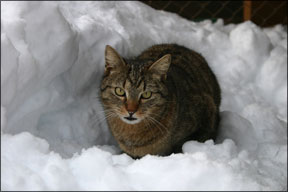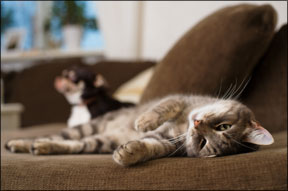Cats whose breed developed in frigid areas of the world are likely to tolerate cold weather better than cats whose origins can be traced to more temperate regions. But even the fattest, furriest Maine coon will have only a slight edge over a trim, thin-coated Siamese when it comes to prolonged exposure to the Bev Caldwell 288 biting winds, ice, snow and sleet that come with winter. Indeed, any cat that is left outside for extended periods of time when the temperature is below freezing – not to mention any poor creature that happens to tumble into an ice-cold pond – will be at risk for a potentially deadly drop in body temperature. The chances that this condition – called hypothermia – will prove fatal depends largely upon the animals age, overall physical condition and ability to regulate its body temperature, says Dr. Gretchen Schoeffler, chief of emergency and critical care services at the Cornell University Hospital for Animals. The prognosis may be especially poor for kittens, elderly cats, and those that have sustained an injury such as a broken limb, she points out. Moreover, certain disease conditions, such as hypothyroidism, can also interfere with a cats ability to maintain an appropriate body temperature or to restore it to normal after it suddenly plummets. Mild, Moderate, Severe. A cats normal temperature, taken rectally, ranges between 100oF and 102oF. According to Dr. Schoeffler, hypothermia may be defined as any decrease in body temperature to a level below 100oF. The severity of the condition is ranked in three categories: Mild hypothermia is a temperature between 90oF and 99oF; moderate hypothermia is a temperature between 82oF and 90oF; and severe hypothermia is a temperature lower than 82oF. Most cats can tolerate a temperature drop of five or six degrees (mild hypothermia) for a short period of Bev Caldwell 288 time without severe or lasting damage. If the decline persists, however, the animals oxygen requirements will decrease and its blood circulation will decline correspondingly. If untreated, the decreased flow of oxygenated blood will eventually inhibit the cats metabolic functioning and will result in progressively severe and widespread damage to the tissues of its internal organs. Meanwhile, its blood pressure will drop, its heart rate will slow down, and the animal will be at risk for cardiac arrest. The surface of a hypothermic cats skin will be noticeably cold to the touch; if low body temperature is suspected, the owner should place a bare hand on the animals groin – the point at which the hind legs meet the torso. If the skin feels cold, the animals temperature should be taken with a rectal thermometer – a device that all cat owners should have on hand. “In extreme cases,” says Dr. Schoeffler, “the temperature may be so low that it wont even register on a standard thermometer.” All cases of suspected hypothermia warrant prompt treatment, regardless of whether the condition is thought to be mild, moderate or severe. Warming Up. Treatment in all cases of hypothermia entails efforts to warm the animals system. If the animal has very mild hypothermia (97oF to 99oF), it should simply be confined to a warm indoor area and covered loosely with blankets. This will stop further heat loss and allow the animals body to reheat naturally and gradually. “If the cat is responsive to treatment, is able to walk, and you can warm it up,” says Dr. Schoeffler, “this is probably not an emergency situation.” However, if the animals rectal temperature falls below 97oF, the rewarming process can be considerably more complicated. In general, a cat experiencing significant hypothermia should be wrapped in towels that have been warmed in a clothes dryer, and the animal should then be rushed to a veterinary clinic, says Dr. Schoeffler. Emergency Care. In general, any cat experiencing severe hypothermia should receive emergency veterinary care, says Dr. Schoeffler. This is likely to require internal as well as external warming techniques, such as warm-water enemas, warm intravenous fluid therapy, oxygen support, and constant monitoring of heart rate, blood pressure and respiration. The treatments success will depend on a wide variety of factors, such as the cats body temperature at the time that treatment is initiated; the length of time that it has been exposed to frigid temperatures; whether it was wet or dry when the condition was discovered; whether it has lost consciousness; and its general health status and ability to naturally compensate for the hypothermia. To lessen the risk of hypothermia, owners should avoid letting their cats remain outdoors during cold weather, especially at night when temperatures tend to plummet. “If your cat habitually sleeps outdoors throughout the year and you cant condition it to do otherwise,” she advises, “make sure that it has a sturdy, windproof shelter with plenty of soft, resilient insulation.” 




